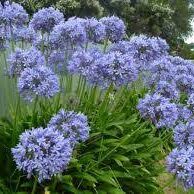Agapanthus Growing Conditions: Dirt, Sunshine, and Watering
Unleashing the Secret to Successful Agapanthus Cultivation: Advice for a Flourishing Yard
In the world of gardening, cultivating agapanthus efficiently requires a critical method that encompasses numerous elements of plant treatment. By understanding the subtleties of agapanthus cultivation, one can produce a setting where these plants flourish and grow perfectly.
Planting Agapanthus: Finest Practices
When growing Agapanthus, proper dirt preparation is vital for making certain effective growth and advancement of these attractive flowers. Agapanthus, generally referred to as Lily of the Nile or African lily, thrives in well-draining soil with a slightly acidic to neutral pH degree - Agapanthus. Prior to planting, it is essential to modify hefty clay dirts with raw material such as compost or peat moss to boost water drainage and offer essential nutrients for the plants
To grow Agapanthus, choose an area that receives complete sunshine to partial color, as this will advertise healthy development and bountiful flowering. Dig a hole twice the size of the plant's root round and place the Agapanthus at the very same deepness it was formerly growing. Gently backfill the hole with dirt, pushing down firmly to remove any air pockets around the origins.
Water the freshly planted Agapanthus thoroughly and remain to keep the soil evenly damp, especially during the plant's energetic expanding period. Agapanthus. Applying a balanced fertilizer once a month can better sustain the plant's development and blooming. By following these best methods for growing Agapanthus, you can develop a stunning display of these fascinating flowers in your garden
Ideal Soil Conditions for Agapanthus
For optimal growth and blooming success of Agapanthus plants, making certain the dirt conditions are suitable is crucial. Agapanthus prefers dirt that is abundant in nutrients, so integrating a balanced plant food throughout the expanding period can advertise healthy growth and vibrant flowers.

Watering and Feeding Tips
To make certain healthy and balanced growth and vibrant blossoms, correct watering and feeding methods are vital for successful Agapanthus cultivation. Agapanthus plants profit from routine watering, specifically throughout the growing period.
When it pertains to fertilizing Agapanthus, a balanced plant food with equivalent parts nitrogen, phosphorus, and potassium can be applied in the springtime to promote healthy growth and blooming. Slow-release fertilizers are excellent for giving nutrients slowly over a prolonged period. Avoid over-fertilizing, as this can cause excessive vegetation growth at the expenditure of flowers.
Additionally, including natural issue like compost into the dirt can enhance nutrient levels and boost soil framework, helping in the total health and wellness of the Agapanthus plants. By adhering to these watering and fertilizing ideas, gardeners can ensure their Agapanthus plants thrive and create stunning screens of blossoms.
Pruning and Deadheading Methods
Correct trimming and deadheading techniques play an important duty in preserving the wellness and looks of Agapanthus plants, complementing the necessary techniques of watering and fertilizing for effective farming. Pruning Agapanthus includes getting rid visit of spent blossom heads, yellowing or dead fallen leaves, and general shaping of the plant to advertise far better development. Deadheading, the process of eliminating discolored blossoms, not just boosts the plant's appearance but additionally encourages additional growing.
When deadheading Agapanthus, it is recommended to clip off the blossom stem at the base using sharp, clean shears. This procedure reroutes the plant's power from seed production back into origin and vegetation growth, advertising a much healthier and more robust plant. Routine deadheading can extend the growing period of Agapanthus and stop self-seeding, which can bring about overcrowding.
In regards to trimming, Agapanthus usually advantages from a light trim after blossoming to clean up the plant and urge fresh growth. Reducing the spent blossom stems and getting rid of any kind of dead or broken foliage aids maintain the plant's vigor and overall appearance. Nevertheless, it is necessary to prevent reducing right into the crown of the plant, as this can damage its wellness.

Protecting Agapanthus From Pests and Diseases
Carrying out efficient insect and disease administration methods is vital to guarding the health and vitality of Agapanthus plants in cultivation. Agapanthus are usually sturdy plants, yet they can still succumb to numerous bugs and diseases otherwise correctly looked after. One typical pest that influences Agapanthus is the Agapanthus borer, a caterpillar that passages into the plant, creating damages to the flowers and fallen leaves. To stop infestations, routine inspection of the plants is necessary. If borers are discovered, they can be by hand eliminated, or insecticidal soap can be utilized as a control action.
In addition to insects, Agapanthus are vulnerable to diseases such as root rot and fungal fallen leave areas. By staying vigilant and addressing insect and disease issues without delay, garden enthusiasts can assist you can try these out their Agapanthus prosper and flourish.

Final Thought
In conclusion, successful farming of agapanthus calls for appropriate growing methods, excellent dirt conditions, ample watering and fertilizing, routine pruning and deadheading, and protection from insects and illness. By following these suggestions and tricks, gardeners can make certain a growing yard filled up with attractive agapanthus blooms. Agapanthus. Keep in mind to keep consistent care and interest to detail to advertise the wellness and longevity of these stunning plants
When planting Agapanthus, appropriate dirt preparation is essential for guaranteeing effective growth and development of these stunning flowers.Water the recently planted Agapanthus completely and continue to keep the soil uniformly damp, particularly during the plant's find out here active growing season.For ideal growth and blooming success of Agapanthus plants, guaranteeing the dirt problems are excellent is critical. When planting or transplanting Agapanthus, make certain the dirt is well-prepared to give the essential foundation for the plants to develop themselves efficiently. One common parasite that affects Agapanthus is the Agapanthus borer, a caterpillar that passages into the plant, causing damage to the leaves and flowers.